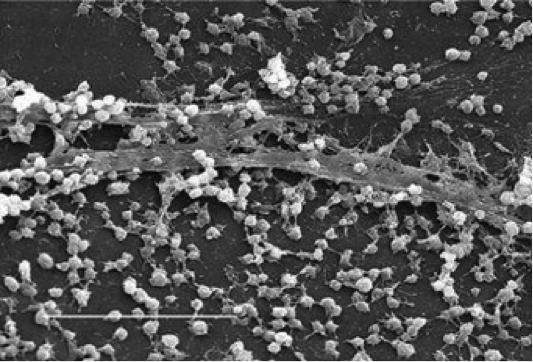Management of Biofilms
As discussed over the previous two weeks’ articles, biofilms are communities of microorganisms that attach to the wound surface encasing themselves in an extracellular polysaccharide matrix.1 As biofilms can present a real barrier to wound healing, it is important that they are identified and dealt with as a matter of priority.2
The first step towards managing a biofilm-related infection is achieving early detection.1 Biofilms are less sensitive to both nutritional stimulation and hostile attacks than planktonic cells and are therefore difficult to detect using traditional agar and culture-based detection methods. Biofilms usually need to be detected by direct microscopic examination or molecular techniques – procedures that are unfortunately not a routine part of most wound management.
Once a biofilm has been identified, action can be taken to combat it. As commercial topical agents and wound dressings currently in use are ineffective against the biofilm matrix, multiple strategies including wound debridement and use of anti-biofilm agents should be employed.1
Debridement
Sharp and ultrasonic debridement has been shown to open up all the devitalized tissue including tunnels and undermining to remove biofilms.3,4 However, no form of debridement will remove all traces of the biofilm, and any remaining bacteria have the potential to re-form the biofilm. Debridement has therefore been recommended weekly with appropriate adjunct therapies. [4]
Broad-Spectrum Antibiotics
Systemic broad-spectrum antibiotics, together with broad-spectrum topical antiseptics, may be helpful in suppressing the many subpopulations within wound biofilm. Systemic antibiotics that are known to be effective by interfering with the cell membrane may also be helpful. [5]
Biocides & Antiseptics
The mainstay of biofilm management currently is the use of biocides or antiseptics, including ionic silver. Ionic silver has been used for hundreds of years and has demonstrated its effectiveness against many bacteria. Ionic silver is currently incorporated into many wound care dressings and the antimicrobial effect has been proven. [3]
Inhibitors
New approaches to the management of biofilms include the development of quorum-sensing inhibitors such as RNA III inhibitory peptide. [3] Research is underway to identify other quorum-sensing inhibitors, as well as anti-adhesion agents and species-specific killing strategies.
Management of Biofilms Still Under Research
After two decades of relentless effort and a quarter of a million publications, the first anti-biofilm-based product has yet to be launched. The hopes of designing an effective strategy against biofilms rest in the new approaches currently under research. Until such new strategies are readily available, wound care professionals must manage biofilms using any means at their disposal.
Management of biofilms is complex, and no single strategy is appropriate for all cases. To learn more about managing this complex phenomenon and other advanced wound care issues, consider pursuing further wound care studies as part of your ongoing professional development.
Learn More With Our Wound Care Education Options
Interested in learning more about wound care and certification? Browse through our wound care certification courses for information on our comprehensive range of education options to suit healthcare professionals across the full spectrum of qualifications and experience.
Scanning electron micrograph of a Staphylococcus biofilm3
References
- Image reproduced from Spear M. Wound Care Management: The biofilm challenge: breaking down the walls. Plastic Surgical Nursing. 2011; 31:117-120.
- Chen Li and Wen Y-m. The role of bacterial biofilm in persistent infections and control strategies. Int J Oral Sci. 2011; 3:66-73.
- Myers BA. Wound management principles and practice. 2nd ed. Upper Saddle River, NJ: Pearson; 2008.
- Spear M. Wound Care Management: The biofilm challenge: breaking down the walls. Plastic Surgical Nursing. 2011; 31:117-120.
- Wolcott R., Rhoads D. A study of biofilm-based wound management in subjects with critical limb ischaemia. J Wound Care, 2008; 17(4): 145-155.
- Rhoads D., Wolcott R., Cutting K., Percival S. (2007). Evidence of biofilms in wounds and the potential ramifications. BiofilmClub.


lvcharles from the caribbean
I,ve tried [email protected] and the link is not going through when submitted. I,ve also read FAQ for
the lpn and lvn eligibility courses it reported that there is no payment plan. The information somewhere in the website is saying anyone can sign up but not every on will be allowed to write the exam. Now, why ask persons to sign up study and cannot sit the exam? So now my direct question to you is, can caribbean student sit the exams online? and can that student submit a copy of a certificate obtained at our nursing school or a transcript? If I have to pay full price up front plus a registration fee, I will like to know I can write the exam or have a money back quarantee. I’m so eager to be wound certified, I’ve been dealing with wound more
half of my career.